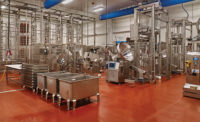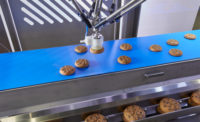Achieving greater efficiency in snack food and bakery plants can come from a variety of different initiatives. The initial design and construction of facilities can be thoughtfully laid out and executed with efficiency in mind. An existing plant can be restructured in ways small and large to streamline the production of snacks and baked goods. And operations leadership can align production with the goals of maximizing resources such as energy and water.
Clean design
Among the areas to consider in achieving efficiency through design and construction is clean design of platforms and walkways—a common feature across snack and bakery production facilities. Westmont Engineering, Broadview, IL, provides prefabricated, custom design of these structures to ensure they’re both easy to clean and do not have harborage points in which bacteria can fester. “We do a lot of food work,” says Doug Morey, president. “There’s a real need for clean design. Oftentimes, the time people spend cleaning their equipment is time they’re down. Efficiency is based in part on the time their lines are down.”
The ease of cleaning and lack of harborage points helps to boost efficiency, Morey says. “We’re very cognizant of hollow structures,” he says. “They look nice aesthetically. But the trouble is that oftentimes, there’s harborage points with holes that electricians or pipefitters put in for mounting conduit, or gaps in the welding.”
Westmont Engineering uses bar stock or plate with no internal harborage points, with the minimal amount of connections between pieces that the strength of the platform necessitates. Joints are 100 percent welded, Morey says. “During washdown, they don’t need to go between grooves,” he says. “They can go up there and hose it down.”
The company uses bent plates for the legs of platforms and walkways, whether or not it’s the most aesthetically pleasing structure. “Again, tubes look great, but they can be easily tapped into through harborage points,” Morey says. “One plant we dealt with had Listeria problems over and over again—from harborage points they didn’t even know about. We went in there six months ago, and they haven’t had problems since then.”
The prefabricated nature of Westmont Engineering’s work streamlines the efficiency of installation, since they can build large pieces offsite—although not necessarily the whole platform or walkway. For example, they once were asked to build a 30x16-foot platform that had to be taken up through a 10x10x8 elevator. “Our installation time was four days. It was really incredible,” says Morey. “We put it in around existing equipment.”
A M King Group, Charlotte, NC, works with snack and bakery manufacturers on design and build, as well as assisting with projects designed to streamline production, says Jon Miller, director of business development.
Snack and bakery companies need to consider the tradeoffs between flexibility and speed in designing plants, Miller says. “You have some plants built for high production, high speed, low SKU. They’re set up in one way, and you have a line that’s going to run 24-7, 365,” he says. “You might have an area of the plant that can allow for smaller equipment, more changeovers, based on consumer trends and tastes. Some plants want to produce only one, some only the other, and some are going to this hybrid format.”
Miller notes that plant sanitation and food safety, with the Food Safety and Modernization Act (FSMA) in mind, is paramount in any design-build project today. “We’re very focused on both employee flow, as well as product flow,” he says. “You’re bringing in raw goods into mixing, into production and through packaging. You want to make sure that flow is very controlled. It’s important to make sure employees are moving through designated areas in the correct sequence, as well.”
Streamlining production
Equipment companies have been streamlining their machines in light of how the production flow typically goes through a bakery, Miller says. “We’re having to redesign around that equipment,” he says. “It’s how we interact with equipment makers, in harmony with that equipment line. We need to streamline that and make it more efficient. That changes the layout and design of the bakery.”
A key aspect of streamlining production is setting up a building with a flexible layout, Miller says. “What that means is having a center core that can lead down the facility and allow for the plant operations to operate on one side of it—but allow the flexibility for future expansions and future equipment changeovers,” he says. This includes establishing the utility trunk lines in such a way that future additions and expansions can easily tap into them.
Snack producers and bakeries might have equipment and lines that currently are running at high efficiency, but after a few years consumer trends might start to change, so plants need to adjust, Miller says. “Now we want the better-for-you baked goods,” he says. “Now we want less allergens, or gluten-free. Designing and building a bakery that allows them to have the flexibility in how to do their production is huge.”
Other efficiency-related streamlining issues include lighting, such as LEDs and natural lighting, Miller says. “Work environment quality has become a big trend,” he says. This often means trying to allow in natural light in while keeping production focused on safety and security, he notes. It’s also appealing to improve aspects of facilities like break rooms or locker rooms, areas that make the workplace more enjoyable.
That’s partly due to labor shortages, Miller says, which in turn has fueled another production efficiency-related trend: automation. Examples that help improve efficiency and throughput—and often worker safety—include automated ingredient delivery via silos into mixers, as well as automated pan retrieval, he says.
Maximizing resources
Douglas Machines Corp., Clearwater, FL, sells washers to snack and bakery customers looking to reduce use of water and detergent, as well as usage of energy inputs from utilities like electric, steam and gas—all while meeting the needs of food safety and FSMA. “We’ve always strived to manufacture our machines so they are efficient,” says Kevin Quinn, sales manager. “A few years ago, the federal government mandated that companies who use electric motors use what’s referred to as a high-efficiency motor. Simply put, the energy use for the motor is reduced.”
Douglas Machines works to maximize resources to meet customer needs, Quinn says. Often, in years past, washing and sanitizing equipment was an afterthought, he says. “You dealt with it in manual fashion until you no longer had the space. Then, people considered a washer.”
But when it came time to make a capital investment, snack and bakery plants would frequently still prefer to add a production line, because they could see where that made the company money, Quinn says. “Washing lines don’t—except when you consider the efficiencies,” he says. “Our systems use recirculated wash tanks. Every time one of our washers cleans something, it’s followed by a separate fresh-water rinse coming from a separate tank. With recirculated fresh water, as well as the detergent being recirculated, there’s water and detergent savings.”
Douglas Machines also has helped snack and bakery companies maximize resources to achieve efficiency by “reinventing” the bakery rack washer into a scale parts washer. “The machine comes with a set of custom racks used to fill weigh hoppers, feed hoppers, pans and chutes,” Quinn says. “My customers tell me that to clean a 16- to 18-head weigh scale might take two hours, and it invites damage because people are handling sensitive stainless-steel parts. You can wash and sanitize in our machine in five minutes.”
That greatly increases the speed at which a plant can turn a production line around. “And,” says Quinn, “as we all know, production uptime is money.”





